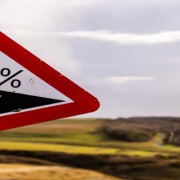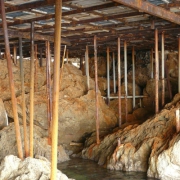Dealing with Russia – what makes sense for European gas
It is hard to ignore Russia in today’s newscast and even those not interested in European energy policy become acutely aware that we Europeans utterly depend on them, the folks from the East, for a large part of our energy security. This is a house of cards built on sand, but not so much for the reasons that lie bluntly on the surface today. The real danger is lurking much deeper and is way more potent.
However, let us take a peek at what glares into the casual observer’s face. Europe depends on a hefty portion of its natural gas consumption on deliveries from Russia – where is the news? Depending on the country that can be anything from pretty low dependence such as France to as high as 100% dependence for countries such as Finland. If Russia turned Natural Gas off for a while, there is little that can be done to assuage the situation immediately. Most countries have storage in place which allows them to hold for a little while but also that wears thin very quickly if the standoff lasts.
However, it’s not only Russian behavior that’s a gamble. The biggest of all gas delivery pipeline systems from Russia passes over Ukrainian territory. Given the wrong kind of development, Ukraine could stop gas transit through its territory at any time producing the same effect as a Russian stop. Just imagine a protracted civil war in the Ukraine – impossible to imagine? What was the chance for civil airplanes crashing into office towers before September 11? What chance did you see in a European country annexing part of another one after Hitler until a couple of weeks ago?
Nevertheless, all that pales in significance when taking a look at the existing Russian gas infrastructure – upstream and transport. Is Russia (and Gazprom for that instance) capable of delivering the volumes of gas that Europe needs to feed its economies? Most production and transport infrastructure in operation in Russia today stems from before Brezhnev’s times. The big Siberian gas fields have all peaked long ago and are hence way past their prime. The main strands of Russian pipelines are also more than 40 years old and are falling apart.
If Russia had to develop those gas reserves out of nothingness today, it all would most likely remain stranded gas. Today we know that shale gas (provided the right kind of environment is created) can be produced for as cheap as USD 4 per MMBtu or possibly cheaper. Siberian Arctic fields may be conventional but the challenges of this extreme environment pile additional cost on top of anything you do there so they will likely be more expensive than US shale. That means freshly developing Arctic fields in Russia will not exactly be a walk in the garden. In addition, transporting it then for thousands of kilometers of nothingness until it reaches Western Europe also has its price.
Back then in the Sixties, this was not a problem as Russian conscript labor and a lack of any economic checks and balances made this colossal endeavor work. In today’s world, the market reigns and consumers will shun expensive Russian gas if there is a locally produced, cheaper equivalent. Shale could be such an equivalent.
Russia has done nothing to replace its creaking gas infrastructure, as doing so would probably price the Russian gas out of the market. Instead, they concentrated on somehow useless glitzy diversion projects such as North or South Stream. Moreover, they work on the gas pipeline system leading to China which shall give them an alternative to queasy European customers. Chances are, that in a couple of years, Gazprom will be unable to fulfill its supply obligations because its supply systems fail for lack of replacement and upgrading. The Crimean crisis is just the drop that makes the barrel spill over.
Just to make matters worse, the shale gas boom in the US has made energy there very cheap, reinforcing the crisis in Europe by industrial relocation to North America. Paradoxically, this, in turn, lowers energy consumption in Europe and hence it makes the shortfall look smaller. However, it’s a devil dressed up as a blessing as lower energy consumption in Europe also means lower economic output and hence performance. This, in turn, means less money in the average European consumer’s pockets and fewer jobs and that is probably not, where we want to go. The question is hence not only – what supply we can use to replace Russian gas but even more urgently, “What energy supply makes us competitive with North America again?”
That’s a hard one, as it rules out most of what’s been going on right now such as more windmills or more solar. This Energiewende is not working to make Europe a better place. Paradoxically, despite the Energiewende and record numbers of windmills and solar panels in operation, greenhouse gas production in Europe is high.
We need gas and we need gas to be competitively priced. Norway is pumping at capacity and even if there is still some oomph in the North Sea fields, it is probably not going to turn the situation around. The Middle East is far away and has Turkey between them and us, which not only makes transport pricey but also a hefty political gamble – just consider the situation in Turkey itself. Besides, the volumes are just not there, as those who have gas either prefer to keep it to themselves or are eyeing juicier markets than Europe. North Africa is not going to play as Libya is a mess and Algeria and Egypt have problems meeting their burgeoning domestic demand.
Remains – shale gas, manufactured gas, and LNG imports. Let us hit the shale gas issue right now. Shale will have to be developed in some places if Europe is serious about making itself competitive again. Moreover, if European shale is structurally more expensive than US shale right now, we better start working on making it less expensive – the Americans have shown us that it can be done so no excuses, please. We are sandwiched between Asia, with its still cheap labor, and the US, with cheap energy plus the Chinese put real strong effort into making shale work for themselves. It is safe enough, much safer than many things we routinely do in many economic areas today, so please let’s drop the crap and get going. Every day dithering is jobs lost and that will be difficult to regain.
However, that cannot be everything. There also is a lot of room for improvement when it comes to manufactured gas. I do not want to rattle on with everything that happens in this sector as this is subject to other posts on this blog but it is a long-term strategic development that must be pursued vigorously on all fronts. I am talking about BioMethane and Synthetic Methane at the same time here.
Last – LNG imports. If we wish to be competitive with the US again, then LNG import from the US will not be an option. US gas is only cheap if you use it in the US. As soon as you need to apply the cost of liquefaction and transport to this feed-gas price, it will become at least as expensive as what we have now and that does not work for making us leaner and meaner. Then the only place that has the potential and is close enough is Sub-Saharan Africa. Yes, it is not an easy place to do business but so are many other areas in the world including many European countries.
In Africa, Nigeria has a special place as it is the biggest gas reserve holder by any measure, and because much of this gas is either undeveloped or flared it is a burden to the environment. Africa could become a supply base for reasonably priced LNG on stable supply arrangements. Africa and Europe are natural partners as much as Europe and Russia are. However, both need to invest in this partnership now to make it real. How African LNG could be structured intelligently and how to work around local African issues is another story you are going to read soon on this blog.


















Leave a Reply
Want to join the discussion?Feel free to contribute!